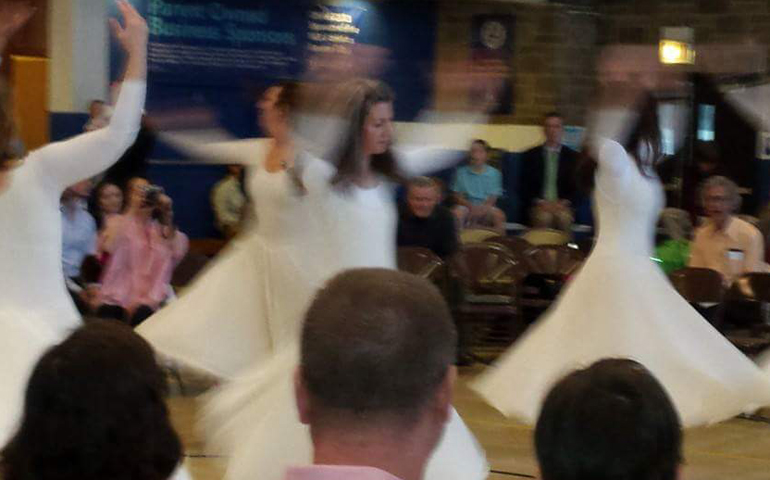
Liturgical dancers at St. Gertrude Parish in Chicago provide prayerful meditation at the Easter and other special liturgies. (Heidi Schlumpf)
My son's first school dance didn't actually feature a whole lot of dancing. Instead, the third-, fourth- and fifth-graders mostly ran around and made visits to the snack bar. But my 9-year-old son did save one spin on the dance floor for his chaperoning mama.
While he and I boogied under the strobe lights, a teacher yelled to me over the rap music: "I bet you have dance parties at your house."
I nodded. Yes, the kids and I do like to crank up the tunes and get down in the dining room. But we're connoisseurs of all kinds of dance in our family, not only signing the kids up for ballet and hip-hop lessons, but also attending international and modern dance performances.
We also enjoy dance at — gasp! — church.
Yes, I'm about to wade into one of the most controversial liturgical issues in America, second only to whether or not to hold hands during the Our Father. Here I go. …
I like liturgical dance. And, after appreciating it for years at my parish, I finally joined the dancers who provide prayerful movement during special liturgies.
I'm certainly not an experienced liturgical dancer, but I can say that the members of our parish dance group are deeply spiritual Catholics who volunteer their valuable time to choreograph, practice and provide an artistic expression of their faith.
Yet, so many Catholics find liturgical dance abhorrent, at worst, and irrelevant, at best. To be honest, I'm baffled by the negativity, since our sacramental church embraces so many other art forms in our liturgies and churches. Paintings? Yes. Sculpture? Of course. Stained glass, fiber arts, mosaics? No problem. Music? To be fair, there are lots of opinions about that, too, but at least most agree that music as a genre is OK in church.
But dance? If you Google "liturgical dance" and "Mass," the top three results are arguments against it. One priest, quoted on a Catholic website, called it "spiritual and liturgical terrorism."
Cardinal Francis Arinze of Nigeria, former prefect of the Congregation for Divine Worship and the Sacraments, has dissed dance as mere entertainment that has no place in the liturgy. "Dance easily appeals to the senses and tends to call for approval, enjoyment, a desire for repetition," he wrote in Celebrating the Holy Eucharist.
Arinze hints at what many who have disdain for dance complain about: that it's too much of a performance. Yet, churches make allowances for non-congregational singing — for post-Communion reflections, for example — with few complaining that meditative music or singing is "performance."
The vehemence and vitriol against liturgical dance has me wondering why something fairly innocuous could incite such strong emotions. Then I remembered the gender of most liturgical dancers: female.
The fact that liturgical dance involves women's bodies is hardly hidden in the subtext of the 1975 Vatican document frequently cited as forbidding the practice. While it allows that in some "primitive" cultures dance is associated with religious values, in Western cultures:
"Here dancing is tied with love, with diversion, with profaneness, with unbridling of the senses. ... For that reason it cannot be introduced into liturgical celebrations of any kind whatever: That would be to inject into the liturgy one of the most desacralized and desacralizing elements, and so it would be equivalent to creating an atmosphere of profaneness which would easily recall to those present and to the participants in the celebration worldly places and situations." (Dance in the Liturgy)
Despite the fact that our God became flesh and took on a human body, the Christian tradition has "left a legacy of body denial," as author Christine Valters Paintner puts it in her book, The Wisdom of the Body. Women's bodies, in particular, have been seen as a source of sin, as profane and desacralizing.
Consequently, many of us feel disconnected from our own bodies and especially unable to connect our bodies to our faith. In her book, Paintner encourages "conscious dance" as a meditative practice to help people reconnect with their bodies — and if that automatically causes you to snicker, it may be precisely because movement brings out the fear of what emotions may come up.
Our emotions are not our enemy, nor are our bodies. Instead, they can be sources of wisdom and even grace, Paintner argues.
The more recent Instruction: Inculturation and the Roman Liturgy, from 1994, makes allowances for dance in the liturgy, but again only "among some peoples" for whom "singing is instinctively accompanied by hand-clapping, rhythmic swaying, and dance movements." And dance can only be allowed if it's an "expression of true communal prayer of adoration, praise, offering and supplication, and not simply a performance."
In that case, I should be OK on Easter morning, when five other women and I will do our best to help convey the joy of Jesus' resurrection through what I believe is "true communal prayer of adoration, praise, offering and supplication."
And I am definitely one of those "peoples" for whom music is instinctively accompanied by "rhythmic swaying and dance movements." Just ask the teacher at the school dance.
[Heidi Schlumpf teaches communications at Aurora University and is the author of Elizabeth Johnson: Questing for God.]




